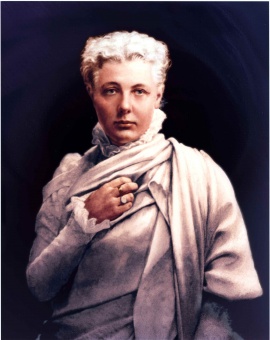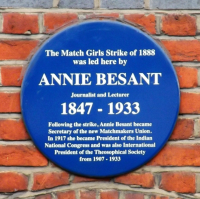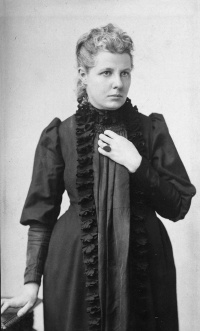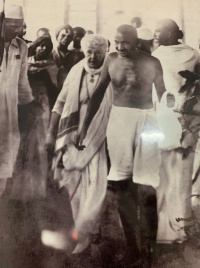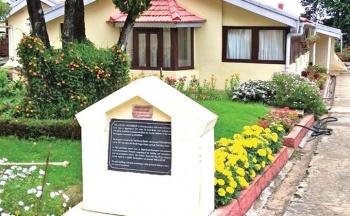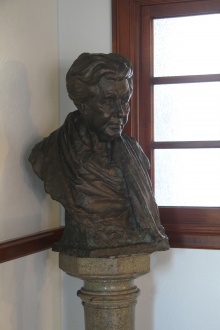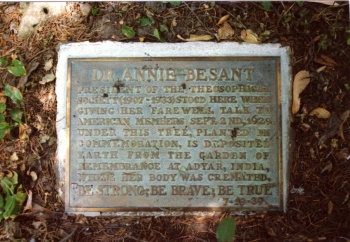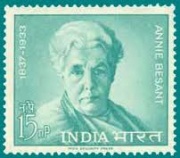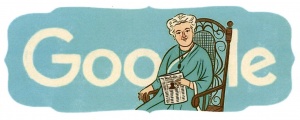Annie Besant
Annie Besant (1 October 1847 – 20 September 1933) was an Anglo-Irish orator, writer, and social rights activist. She is well known from her role in the Indian National Congress during the struggle for Indian home rule, and for her support of national education in India. She was president of the Theosophical Society based in Adyar, Chennai, India, from 1907-1933.
See also Besant writings and Besant lectures.
Early life and family
Annie Wood was born in London on October 1, 1847, to middle-class parents William Page Wood and Emily Morris, of Irish origin. Annie's childhood was difficult. Her father, a doctor, died when she was only five years old, after accidentally contracting tuberculosis from a deceased man. His death left the family severely strained financially. Not long after this, one of Annie's brothers died too. Her mother tried running a boarding house for boys at Harrow School but was unable to support her daughter. In 1855, she put Annie under the care of her philanthropic friend Ellen Marryat, who would be able to provide the girl a good education. This changed Annie's life drastically. She was educated privately in England, Germany, and France, and was awarded honors in botany following the Preliminary Science Exam at London University, and the South Kensington Science and Art Exam.[1] She was an expert archer and croquet player, and rode horses often before 1889 and after 1900.[2]
At eighteen Annie got engaged to shy and austere evangelical Anglican, Frank Besant, the vicar of Sibsey, Lincolnshire. Two years later, in 1867, she married the 26-year-old clergyman. Within a few years the couple had two children, Arthur Digby Besant and Mabel Emily Besant. The marriage, however, was not a happy one. Conflicts arouse over Annie's independence as well as her religious and political concerns, but she was also physically ill-treated by her husband. So terrible was her marriage that once, with poison in her hand, she thought of committing suicide. As she was about to drink it she heard a clear voice of stern reproval, which said to her: "O Coward, coward, who used to dream of martyrdom and cannot stand a few years of woe". She instantly threw the bottle out of the window and never forgot the voice.[3]
Divorce was impossible under the existing laws. Eventually, in 1873, she left her husband and returned to London, keeping the custody of her daughter.
Digby... was to stay with his father, and his mother only had visitation rights for one month out of the year. Still legally married to Frank, up to his death in 1917, Annie Besant was obliged to keep her married name, but she modified the pronunciation, moving the stress from the second to the first syllable.[4]
Early social activism
Around the time of her marriage Annie visited some friends in Manchester, where she got into contact with both English radicals and the Irish Fenian Martyrs of Manchester. Through elderly lawyer William Roberts, much loved by the workers of Manchester for his unpaid work on their behalf, she became acquainted with the conditions of the urban poor. All this awakened her political and social consciousness.
After her marriage Annie began to support farm workers who were fighting to unionise and to win better conditions; her husband sided with the landlords and farmers.
During her marriage and soon after her separation, Annie began to lose her faith in Christianity and gradually fell into atheism and the Freethought movement, which sought to alleviate human suffering through education and social reform. In the summer of 1874 she became a member of the National Secular Society. In 1875, she would be elected as its vice-president. During this stage of her life she would become a remarkable supporter of freedom of thought, women's rights, secularism, birth control, Fabian socialism and workers' rights.
At the head of the movement was Charles Bradlaugh, who soon developed a close relationship with Besant. He was the editor of the radical newspaper the National Reformer and gave her a job working for it as a columnist and reviewer. During the next few years she wrote many articles on issues such as marriage and women's right to vote, trade unions, national education, birth control, and the abolition of capital punishment. At this time Besant also developed a reputation as an outstanding public speaker. Her first talk was on "The Political Status of Women" and it was a success, printed later as a pamphlet.
Besant began to lecture around the country, sometimes along with Bradlaugh, sometimes by herself, and soon became one of the most prominent champions of atheism and freethought in Britain.
The Fruits of Philosophy
Besant and Bradlaugh became household names in 1877 when they republished a pamphlet promoting birth-control by the American Charles Knowlton entitled The Fruits of Philosophy. The work claimed that in order to be happy, working-class families had to be able to decide how many children they wanted. The pamphlet was highly controversial and caused a real scandal, especially among the religious establishment. It was vigorously opposed by the Church and eventually banned as an "obscene work."
They were arrested and put on trial; charged with publishing material that was "likely to deprave or corrupt those whose minds are open to immoral influences." In court they argued that "we think it more moral to prevent conception of children than, after they are born, to murder them by want of food, air and clothing."
During the trial Besant was instrumental in founding the Malthusian League, which would advocate for the abolition of penalties for the promotion of contraception. She wrote and published her own birth-control pamphlet with a "less coarse" style entitled The Laws of Population. The idea of a woman advocating birth-control received wide-publicity. Newspapers like The Times accused Besant of writing "an indecent, lewd, filthy, bawdy and obscene book." They were both found guilty of publishing an "obscene libel" and sentenced to six months in prison. However, the conviction was quashed on appeal due to a technicality.
In spite of the legal victory, Annie had to pay a terrible price for the scandal. Rev. Besant used the publicity of the affair to file a case for the custody of their daughter Mabel. He was able to persuade the court that she was unfit to look after her on the grounds of Annie being an atheist, associated to infidel Charles Bradlaugh, and promoter of an indecent obscene pamphlet.
The loss of her two children caused her great grief. When they grew up, however, they both became devoted admirers of their mother.
The Match Girls
In the 1880's Besant began to shift her political views, deserting Bradlaugh's radicalism for the more moderate socialism of the noted organisation, the Fabian Society. Annie hesitated for a time before changing her allegiance, which would bring her "into collision with the dearest of my friends." Finally, she publicly embraced Socialism in the Summer of 1885, during a lecture by a young and little-known George Bernard Shaw. As they became acquainted, he greatly admired her skills as a lecturer: "Now at this time Mrs. Besant was the greatest orator in England, and possibly in Europe... I have never heard her excelled."[5] He saw her involvement in Fabianism as a means of developing her organizational skills and teamwork.
In selecting the Fabian Society for her passage through Socialism Mrs. Besant made a very sound choice; for it was the only one of the three Socialist Societies then competing with one another in which there was anything to be learnt that she did not already know. It was managed by a small group of men who were not only very clever individually, but broken in to team work with one another so effectually that they had raised the value of the Society's output far above that of the individual output of any one of them... This was exactly what Mrs. Besant needed at that moment to complete her equipment."[6]
This was a time of growing working class agitation, increased by poor working conditions and high unemployment. By the end of 1887, a mass rally against unemployment was held in Trafalgar Square; Besant was a key speaker at the event. The rally was disrupted by the police, leading to one death and many injuries. The events created a great sensation, and became known as "Bloody Sunday." Besant took the charge of organizing legal aid for the jailed workers and support for their families.
Some months later, young socialist Herbert Burrows brought to her attention the health-threatening situation of young women workers at the Bryant & May match factory. They worked long hours for low pay and were liable to suffer from industrial illnesses. At the time, the matchstick industry was a very powerful lobby, since electric light was not yet widely available, and matches were an essential commodity. On June 23, 1888, Annie published an article "White Slavery in London", where she drew attention to the dangers of phosphorus fumes, and complained about the low wages paid to the women. The three who provided information for Annie's article were fired. Annie helped the women to form a Matchgirls Union and, after a three-week strike, the company was forced to make significant concessions, including the re-employment the three victimized women. The public sympathy and success of the strike was an important development in the unskilled trades union movement.
Read more: Out of the shadows: the women who sparked the Labour movement by The Guardian newspaper.
Introduction to Madame Blavatsky
In spite of the success in her social activism Besant was still unhappy and felt a deep void. In recalling this period of her life she wrote:
Ever more and more had been growing on me the feeling that something more than I had was needed for the cure of social ills. The Socialist position sufficed on the economic side, but where to gain the inspiration, the motive, which should lead to the realisation of the Brotherhood of Man?[7]
For a few years now she had been growing dissatisfied with the field of social reform. She saw the limitation of its reach to solve humanity's problems. She had also failed to find and "organise bands of unselfish workers" and was wondering "where was the material for the nobler Social Order". As a result of this she had also become interested in psychology, hypnotism, dreams, etc. It was at this time that she came across A. P. Sinnett's first book, The Occult World, which explained the seemingly supernatural phenomena as being part of unknown aspects of the natural law. She then started researching into Spiritualism and phenomena such as clairvoyance, clairaudience, and thought-reading.[8]
One day, in 1889, an event happened that would mark the beginning of a new life. She wrote:
I was making desperate efforts to pierce the darkness, and was seeking with passionate earnestness to obtain some direct evidence of the existence of Soul and of the superphysical worlds; one evening as I sat alone, concentrating my mind on this longing, I heard the Master's voice--but knew not whose it was--and after some questions asked by Him and answered by me, came the promise that I should soon find the light--a promise quickly verified.[9]
This voice, unknown to her at the time, was that of the Mahatma Morya, who was to become her Master. He had asked her: "Are you willing to sacrifice everything to find Truth?", and she replied, "Yes, Lord". Then the voice continued: "You will find it soon." She did not know who had spoken, but it was the same voice as on the earlier occasion.
Two weeks later her friend W. T. Stead, the famous Editor of the Pall Mall Gazette and founder of the journal Review of Reviews, gave her two large volumes asking her if she could review them. "My young men all fight shy of them, but you are quite mad enough on these subjects to make something of them." The books were the two volumes of The Secret Doctrine, written by H. P. Blavatsky. She described her experience in reading the book as follows:
As I turned over page after page the interest became absorbing; but how familiar it seemed; how my mind leapt forward to presage the conclusions, how natural it was, how coherent, how subtle, and yet how intelligible. I was dazzled, blinded by the light in which disjointed facts were seen as parts of a mighty whole, and all my puzzles, riddles, problems, seemed to disappear. The effect was partially illusory in one sense, in that they all had to be slowly unravelled later, the brain gradually assimilating that which the swift intuition had grasped as truth. But the light had been seen, and in that flash of illumination I knew that the weary search was over and the very Truth was found.[10]
She wrote the review and it was published in The Pall Mall Gazette (London) on April 25, 1889. Then, she sent a note to the author asking to be allowed to call upon her. Mme. Blavatsky answered with a cordial note of invitation, saying:
I too have long been wishing to make your acquaintance, as there is nothing in the world that I admire more than pluck and the rare courage to come out and state one’s opinions boldly in the face of all the world.[11]
On the evening of May 10, Besant and her friend Herbert Burrows went to meet with Mme. Blavatsky. After some informal conversation Blavatsky expressed her wish to have Besant joining the Theosophical Society. Although she wanted to join, she was aware that this step would produce a rift with all her previous Freethinker and Socialist associates and friends, especially Charles Bradlaugh. She became a member of the Society on May 21, 1889.[12][13]
Seeing the Master
In July 1889, she joined Mme. Blavatsky in Fontainebleau and witnessed the writing of The Voice of the Silence. It was here that she saw the radiant astral figure of her Master Morya for the first time, visible to her physical eyes. She wrote:
I will tell you about the first occasion on which I saw my Master. Soon after I had joined the Society, it happened that I was in England at a time when H. P. B. was in Fontainebleau, France, where The Voice of the Silence was written. She wrote me to go over and join her, which I did with joy. She was living in a delightful old house out in the country, and I was put in a bed-room near hers, a door connecting the two. One night I awoke suddenly owing to an extraordinary feeling that there was in the room. The air was all throbbing, and it seemed as if an electric machine was playing there; the whole room was electric. I was so astonished (for it was my first experience of the kind) that I sat up in bed, wondering what on earth could be happening. It was quite dark, and in those days I was not a bit clairvoyant. At the foot of the bed a luminous figure appeared, and stood there from half a minute to a minute. It was the figure of a very tall man, and I thought, from pictures I had seen, it was H. P. B.’s Master. Near him was another figure, more faintly luminous, which I could not clearly distinguish. The brilliant figure stood quite still, looking at me, and I was so utterly astounded that I sat perfectly still, simply looking at Him; I did not even think of saluting Him. So I remained motionless and then gradually the figure vanished. Next day I told H. P. B. what had happened, and she replied: ‘Yes, Master came to see me in the night, and went into your room to have a look at you.’ This was my first experience of seeing a Master; it must have been clearly a case of materialisation, for as I have said, I was not in the least clairvoyant at the time.[14]
Early Theosophical work
Her decision to join the Theosophical Society met a storm of criticism from her former associates in London. To explain her change of view, on August 4 and 11, 1889, she delivered a lecture in the Hall of Science on the subject "Why I Became a Theosophist."
On September 4 of that year, in HPB’s house, she met H. S. Olcott, co-founder of the Theosophical Society and international President. He immediately recognized her value. He wrote in Old Diary Leaves: "At the time of my [first] visit I had the chance to see of what infinite tenderness and unselfish compassion Mrs Besant was capable,"[15] and, "She is the most important gain to us since Sinnett."[16]
In this month Mrs. Besant began editing the monthly theosophical journal Lucifer with HPB.
On January 17, 1890, she was elected as president of the Blavatsky Lodge. By the middle of the year her rented home in 19 Avenue Road became the new headquarters for the European Section of the TS, where HPB lived until the end of her life.
In August, 1890, Besant became one of twelve members of the Inner Group of the Esoteric Section, formed by HPB. On April 1, 1891, a month before her death, Blavatsky appointed her to the highest official position in the Inner Group, after that of herself:
I hereby appoint in the name of the Master, Annie Besant Chief Secretary of the Inner Group of the Esoteric Section and Recorder of the Teachings.[17]
That year she began her career as international lecturer for Theosophy. In April 1891 she visited the United States for a lecture tour and attended the TS American Section Convention in Boston. Madame Blavatsky introduced her to American Theosophical leader William Quan Judge in a March 1891 letter:
Inegoism and altruism is Annie Besant's name, but with me and to me she is Heliodore, a name given to her by a Master, and which I use with her, it possesses a profound meaning. She's been studying occultism with me for just a few months now in the innermost group of S.E. Esoteric Section, and yet she's gone far ahead of everyone else. She is neither psychic nor spiritual in any way - all intellect, and yet she hears the Master's voice when she is alone, sees His Light, and recognizes his voice from that of "Disinherited". Judge, she is a very wonderful woman, my right arm, my successor, when I am forced to leave you, my only hope in England, just as you are my only hope in America.[18]
Mme. Blavatsky died in London while Besant was on her trip back to London from the United States, and Besant succeeded her as head of the Esoteric Section in Europe.
After the death of Blavatsky, she continued her activities as international speaker, delivering hundreds of lectures in the US, Europe, India, and Australasia. A number of these lectures were published in book or pamphlet form. From 1892 to 1904 she wrote a series of books on Theosophy, including: The Seven Principles of Man, Reincarnation, Death–and After?, Karma, Man and His Bodies, The Ancient Wisdom, Some Problems of Life, Esoteric Christianity; or The Lesser Mysteries, Thought Power: Its Control and Culture, A Study in Consciousness: A Contribution to the Study of Psychology. In 1895 she was awarded the Subba Row Medal award for her 1894 Convention Lectures, published as The Self and Its Sheaths.
Her work in India
On October 20, 1893, Annie Besant departed for India for the first time, arriving there on November 16. There, she would travel extensively for four months giving lectures in many cities. In December she delivered her first International Convention lectures at Adyar, which included a talk on "India and Its Mission."
Talking about the effect of her early work on the Indian mind, especially of the Hindus, Col. Olcott writes:
The development of Mrs. Besant’s relations with our work in India have been, moreover, what, to me, is the best possible evidence that she is, indeed, the agent selected to fructify the seeds which had been planted by H. P. B. and myself during the previous fifteen years. She has swept away all vestiges of the mistrust as to our mission in India, such as was entertained by the great body of orthodox Brahmins, who looked on my colleague and myself as in fact secret agents for a Buddhist propaganda and the would-be destroyers of Hinduism.[19]
Her influence in the educational, cultural, and political life of India would be remarkable.
Indian nationalist movement
The Dictionary of National Biography describes her political activity following Olcott's death:
She poured her superabundant energy into campaigning for self-government by means of newspapers she controlled—The Commonweal and New India—and in lectures such as India Bond or Free? (1926). In 1913 she joined the Indian National Congress. In 1915 she proposed to its executive committee that a network of home rule leagues be set up across the country. While at the outbreak of the 1914–18 war most Indian politicians, including Gandhi, the rising star, called a truce in their opposition to the raj, Besant did not, proclaiming 'England's need is India's opportunity' (New India, August 1914). In 1916 the tragedy of the Dublin Easter rising incited Mrs Besant to new heights of ferocity and contempt. In May 1917 the viceroy, Lord Chelmsford, bowed to Anglo-Indian demands and interned her at Ootacamund. The historic announcement made at Westminster on 20 August 1917... secured her release, when all India celebrated... On 26 December 1917 she became the first woman president of the 32nd Indian National Congress meeting at Calcutta. It was the summit of her influence, which thereafter declined. [20]
Besant's political work for India may be said to have started on December 22, 1894, when she addressed the Indian National Congress for the first time. However, she definitely entered the Indian political arena in 1913, with the goal of achieving dominion status for the country. She joined the Indian National Congress and published a series of lectures entitled Wake Up, India! A Plea for Social Reform.
In 1914, Annie Besant purchased an Indian newspaper, The Madras Standard, and changed its name to New India. She used this newspaper to support the movement for Indian Nationalism, attack the colonial government of India and promote India's self-rule. In 1916 Besant launched the All India Home Rule League and became the first Organizing Secretary of the Central Committee. Organized to demand self-government within the British Empire, this was the first political party in India to have regime change as its main goal.
On June 15, 1917, she and her two supporters, G. S. Arundale and B. P. Wadia, were arrested by the Madras government. They were interned under house arrest the next day in Gulistan at Pudumund in Ooty, which was a property built by H. S. Olcott in 1890 as his summer home. Besant's arrest created a focus for protest and the movement spread out. When, on September 15 of that year, she was freed, crowds all over India welcomed her. In December she took over as president of the Indian National Congress for a year, being the first woman to do so. The demand for self-rule in 1917 is regarded as an important milestone and a turning point in the struggle for Indian independence.[21]
In 1919 Indian political sentiment began to favor native Mohandas Gandhi, who had returned from leading Asians in a struggle against racism in South Africa. He encouraged a mass-based civil disobedience, albeit in a non-violent way. Seventy-three-year old Annie Besant opposed this policy, warning that promoting disobedience would end up in violence. Her proposal was to work for change through the British legal system. Indians followed Gandhi's leadership, eventually leading to the independence of India in 1947, in the midst of violent clashes between Hindus, Sikhs and Muslims.
Work in education
Mrs. Besant was a tireless advocate for improving education in India. She helped to establish the Society for the Promotion of National Education to support school initiatives designed for Indian students in a country that was headed for home rule. She was particularly involved with these schools:
- Besant Theosophical College, Madanapalle, India.
- National School, Bangalore, India.
- National University of India, Chennai, India.
- Annie Besant School, Indore, India.
- Central Hindu College, Benares, India - founded in 1898 and now known as Benares Hindu University.
- Central Hindu Girls' School, Benares, 1904.
- Annie Besant School, Allahabad, India - established October 2, 1926.[22]
- Besant Memorial School, Chennai, India - opened June 2, 1934 under headmaster Sankara Menon, M. A., "a young and brilliant graduate of Madras University.[23]
In recognition for her efforts in the field of Indian education, the Banaras Hindu University conferred upon her the Degree of Doctor of Letters.[24]
She recruited many Theosophists to teach in and supervise the schools, including George S. Arundale, Nilakanta Sri Ram, James H. Cousins, Margaret Cousins, Fritz Kunz, Mary K. Neff, and Ernest Wood.
See also
- Educational Ideas of Annie Besant by Chandra Lekha Singh
Central Hindu College
Soon after her arrival Besant gathered around her a group of Indians interested in the regeneration of their country. After much planning she founded the Central Hindu College in Benares, which now is the nucleus of the Banaras Hindu University. Theosophists from around the world came to India to help in this, including Francesca Arundale and George S. Arundale.[25]
The object of the College was to impart sound secular education, combined with moral and religious instruction, based on the fundamental tenets of Hinduism. The College prepared students for the M.A. and M.Sc. and lower examinations of the Allahabad University till the year 1917. Three years earlier, the management and control of the College had passed from the hands of its original trustees to the Hindu University Society, which was carrying on the work of inaugurating the present University.[26]
Indian Boy Scouts Association
During the course of 1916 Besant organized some troops of Boy Scouts in Madras and Benares. They followed the Scout Law, although the boys wore Indian turbans and sang Indian songs. When a request was sent to the founder of the international movement of Boys Scouts, Robert Baden-Powell, to recognize the Indian troops as part of the international organization, he refused. She then began to campaign for it, publishing an article in her newspaper New India on October 13, 1916, an article entitled "Why not Indian Scouts?"[27] She organized the Indian Boy Scouts Association, based in Madras, headed by herself and George Arundale.
A few other organizations began to be formed in the country. In 1921, when Besant had gathered more than 20,000 members, Baden-Powell came to India, and recognized all the different Scout organizations in the country as part of the international movement. He conferred upon her the Badge of the Silver Wolf, a great honor. It was sent to her by the Viceroy of India, who included a personal letter.[28][29]
See also Boy Scout Movement and Theosophical Movement.
Receiving Mahatma Letter
In 1900, Mrs. Besant received a letter from Mahatma K. H., which was published as Letter 59 in Letters from the Masters of the Wisdom, First Series. (In editions 1945-1974, before the First Series was resequenced in 1988, this was called Letter 46) This is often referred to as the "1900 letter" because it was received many years after the last known letter from the Mahatmas. Due to this timing, doubt has sometimes been cast on the origin of the letter.
President of the Theosophical Society
THIS SECTION UNDER CONSTRUCTION
THIS SECTION UNDER CONSTRUCTION
On July 6, 1907, Annie Besant was elected as International President of the Theosophical Society.
- 1908:
- Initiated the expansion of Adyar property expanding it to 266 acres.
- February: founded the Theosophical Order of Service.
- May: Inaugurated the Vasanta Press in Adyar.
- October: Established the International Order of the Round Table.
- October: Established the Sons of India and the Daughters of India.
As President, Mrs. Besant supervised all the departments of the Adyar headquarters estate; edited The Theosophist; and advised in the management of the Theosophical Publishing House and the Vasanta Press, as well as lecturing throughout the world.[30]
Mr. Jinarājadāsa wrote of her schedule:
Dr. Besant worked from 6:30 a.m. to 8:15 p.m., with half an hour's interval for her midday meal, and half or three quarters of an hour for tea and chat. She took her supper at 8:30.[31]
Invocation
Members of the Theosophical Society (Adyar) around the world regularly recite an invocation penned by Mrs. Besant. C. Jinarājadāsa wrote of its use in the ceremony of reciting the Prayers of the Religions, introduced at the Golden Jubilee Convention of 1925: "The ceremony always concludes with Dr. Besant's beautiful and famous invocation repeated by all:"[32]
O Hidden Life, vibrant in every atom;
O Hidden Light, shining in every creature;
O Hidden Love, embracing all in Oneness;
May each who feels himself as one with Thee,
Know he is also one with every other.
The words were set to music at least twice, by Charles Elliott Fouser and by J. Eleanor Stakesby-Lewis,[33] and another member, W. H. Perrins, proposed yet another version.[34]
Oratory and speaking tours
Throughout all the years of her social activism and Theosophical work, Dr. Besant was much in demand as a public speaker. More information will be found at Besant lectures.
Other work
THIS SECTION UNDER CONSTRUCTION
THIS SECTION UNDER CONSTRUCTION
In the United States, Mrs. Besant purchased land in 1927 to establish the Happy Valley Foundation in Ojai, California. A school was not formed immediately, but with the efforts of J. Krishnamurti and others, the Besant Hill School of Happy Valley now operates on that site.
Editorial work
THIS SECTION UNDER CONSTRUCTION
THIS SECTION UNDER CONSTRUCTION
NOTE - see list at KurtLeland.com.
- The Link was a halfpenny weekly newspaper that Mrs. Besant established with William T. Stead to campaign against "sweated labour, extortionate landlords, unhealthy workshops, child labour and prostitution."[35] Her famous article "White Slavery in London," printed on June 23, 1888, detailed the horrific conditions of girls manufacturing matchsticks.
- Lucifer was established by Helena Petrovna Blavatsky, but Mrs. Besant took over editorship in 1891 following HPB's death.
- As President of the Theosophical Society in Adyar, Mrs. Besant served as editor of The Theosophist.
- The Commonweal, , subtitled "a weekly journal of national reform," was published from January 2, 1914 until March, 1920.[36][37]
- Also in 1914, Mrs. Besant purchased an Indian newspaper, the Madras Standard, and on August 1 of that year changed its name to New India, which was a daily paper promoting Home Rule for 15 years. Its circulation rose to 10,000.
Writings
Mrs. Besant left a large body of books and pamphlets, which are listed in Besant writings.
She also wrote hundreds of magazine articles and editorials. Over 2500 articles written for periodicals of the Theosophical Society located in Adyar are documented in the Union Index of Theosophical Periodicals under the name Annie Besant.
Later years
In 1929, Dr. Besant made her final tour of the United States, and On September 2, 1929, she spoke to members on the Olcott campus in a farewell address.
On September 20, 1933, Annie Besant passed away just before her 85th birthday. She was cremated in Adyar with great ceremony. Half of the ashes were deposited in the Ganges by Bhagavan Das, near the site where Mme Blavatsky’s ashes had been cast. The other half was placed in the Garden of Remembrance at Adyar. Ten years after the final American tour, on July 19, 1939, a fir tree was planted at the place where she last spoke on the Olcott campus, incorporating soil from Adyar's Garden of Remembrance brought by Henry and Marie Hotchener.[38]
Honors, tributes and memorials
In 1922, an honorary doctorate was bestowed on Mrs. Besant by Benares Hindu University. A. P. Warrington was present:
The occasion was that of the conferring of degrees by the University of Benares upon the Price of Wales, our President [Mrs. Besant], and various graduates...
At the conclusion of the ceremonies, the Prince stopped and exchanged a word with the newly-made Dr. Besant. He congratulated her and when Pandit Malaviya generously remarked that but for her there would have been no University, as it was her Central Hindu College that formed the basis of it, the Prince replied that he knew about it and made some reference to the former visit of his parents to the C.H.C.[39]
The Indian government issued a postage stamp honoring Mrs. Besant on October 1, 1963. It was released on her 116th birthday in a ceremony at the Adyar headquarters where she had served as President from 1907-1933. The Governor of Madras State, Mr. Bishnuram Medhi gave a speech praising her role in Indian nationalism.[40]
In addition to the schools she personally founded, other schools that have been named in her honor include Annie Besant School, Meerut, India.[41]
Other groups and places named in her honor include:
- Annie Besant Memorial Hall, Cardiff, Wales - opened in October, 1934.
- TOS Annie Besant Model School, Rayagada, Odisha, India - opened in 1992 by the Theosophical Order of Service in Rayagada.
- Lodges named after Annie Besant were formed in the American cities of Cleveland, Los Angeles, Tulsa, Boston, Seattle, Houston, Nashville, San Diego, Chicago, and Indianapolis.
- Besant Hill School of Happy Valley, Ojai, California - founded in 1946 and renamed in July 2007 in Besant's honor, since she had the original vision of a school established on land she purchased in 1927.
- Annie Besant Memorial Hall at Musaeus College in Colombo, Sri Lanka. Opened October 1, 1937.[42]
Annie Besant in popular culture
On October 1, 2015, a Google Doodle was posted to honor Dr. Besant's 168th birthday.
The DVD release of The Adventures of Young Indiana Jones included a companion historical documentary called "Annie Besant - An Unlikely Rebel." [43]
Biographies
Dr. Besant and her activities are the subject of many biographies, and are also covered extensively in works about H. P. Blavatsky, H. S. Olcott, C. W. Leadbeater, J. Krishnamurti, George Bernard Shaw, M. K. Gandhi, Charles Bradlaugh, birth control, Freethinking, women Freemasons, English trade unions, Hindu Renaissance, Indian National Congress, Indian nationalism, and Indian education. These are some of the biographies:
- Agarwal, C. V. and Pedro Oliveira. Annie Besant in India. Australia, 2021. 590 pages.
- Aiyangar, M V Srinivasa. An Open Letter to Mrs. Annie Besant; Being a Reply to Her Attacks on Hinduism. Madras, M. C. Narasimhacharya [1915]. Available at Hathitrust.
- Aiyar, Ramaswami. Annie Besant. Delhi Publications Division, Ministry of Information and Broadcasting, [1963]. Searchable at Hathitrust.
- Ayar, Ramasamy, C.P., Annie Besant. New Delhi: Publication Division, Ministry of Information and Broadcasting, Government of India, 1963.
- Besant, Arthur Digby. The Besant Pedigree. London: Besant & Co., 1930. Searchable at Hathitrust.
- Besterman, Theodore. Mrs. Annie Besant, a Modern Prophet, London: K. Paul, Trench, Trubner & Co., Ltd., 1934.
- Besterman, Theodore. The Annie Besant Calendar. London: The Theosophical Pub. House, 1927. Searchable at Hathitrust.
- Besterman, Theodore. A Bibliography of Annie Besant. London, The Theosophical society in England, 1924. Searchable at Hathitrust.
- Besterman, Theodore. Mrs. Annie Besant: A Modern Prophet. London, 1934.
- Bright, Esther. Old Memories and Letters of Annie Besant. London: Theosophical Publishing House, 1936. Searchable at Hathitrust.
- Dictionary of National Biography. "Besant, Annie", Dictionary of National Biography. Available at the Oxford DNB website. This is a particularly well-written account of her life.
- Dinnage, Rosemary. Annie Besant. Harmondsworth, Middlesex, England: Penguin Books, 1986.
- Dwarkadas, Jamnadas. Political Memoirs. Bombay, 1969.
- Fussell, Joseph H. Mrs. Annie Besant and the Leadbeater Advice. San Diego: 1913. Pamphlet. Searchable at Hathitrust.
- Hess, Karolina Maria. "Annie Besant & Poland". FOTA Newsletter no. 8 (Autumn-Winter, 2017-2018), 24-31.
- Indian Section, Theosophical Society. In honour of Dr. Annie Besant: Lectures by Eminent Persons, 1952-88. Varanasi, U.P., India: Indian Section, Theosophical Society, 1990.
- Jinarajadasa, C. A Short Biography of Annie Besant. Adyar, Madras, India: Theosophical Publishing Company, 1932.
- Kumar, Raj. Annie Besant's Rise to Power in Indian Politics, 1914-1917. Concept Pub. Co., 1981.
- Kumar, Yudhistera. Annie Besant as an Indian Educator. With a foreword by B. Pattabhi Sitaramayya. Lashkar, Gwalior, Swarup Publications [introd. 1951] Searchable at Hathitrust.
- Mukerji, N. N. Unemployment and Limitation of Family. With 46 illus. and ports. of Mr. Charles Bradlaugh and Mrs. Annie Besant of 1877. Calcutta, N.N. Mukerji, 1918. Available at Hathitrust.
- Muthanna, I. M. Mother Besant and Mahatma Gandhi. Vellore, Tamil Nadu: Thenpulam, 1986. Searchable at Hathitrust.
- Nethercot, Arthur Hobart. The First Five Lives of Annie Besant. Chicago: University of Chicago Press, 1960. Available at Internet Archive, with limited access at Hathitrust.
- Nethercot, Arthur Hobart. The Last Four Lives of Annie Besant. Chicago: University of Chicago Press, 1963. Limited access at Hathitrust.
- Pal, B. C. Mrs. Annie Besant: A Psychological Study. Madras, India: Ganesh, 1917.
- Pécastaing-Boissière, Muriel. Annie Besant (1847-1933): La lutte et la quête. Paris: Éditions Adyar, 2015. English edition: Annie Besant: Struggles and Quest. London: Theosophical Publishing House, 2017. German edition: Annie Besant : Weisheit und Wissenschaft - Die Biographie. Aquamarin- Verlag GmbH, 2017.
- Prakasa, Sri. Annie Besant. Bombay: Bharatiya Vidya Bhavan, 1954.
- Prakasa, Sri. Annie Besant as Woman and as Leader. 3rd edition - Bombay: Bharatiya Vidya Bhavan, 1962. Searchable at Hathitrust.
- Pruthi, Raj. Annie Besant's rise to power in Indian politics, 1914-1917. New Delhi : Concept Pub. Co., 1981. Searchable at Hathitrust.
- Prakasa, Sri. Annie Besant. Bombay, Bharatiya Vidya Bhavan, 1954. 2nd ed.
- Prakasa, Sri. Annie Besant as Woman and as Leader. Bombay, Bharatiya Vidya Bhavan, 1962. 3rd ed.
- Ramaswami Aiyar, C. P. Annie Besant. New Delhi: Publications Division, 1971.
- Stead, W. T. Annie Besant: A Character Sketch 1891. Adyar, Madras, India: Theosophical Publishing Company, 1891.
- Taylor, Anne. Annie Besant: A Biography. Oxford: Oxford University Press, 1992. This is an academic study of Mrs. Besant that gives excellent coverage to her early life and political activities, but less depth to her Theosophical Society activities.
- Theosophical Society. Woman World Honoured: Annie Besant, Warrior. Madras, Theosophical Pub. House, 1943.
- Veritas [pseudonym]. Mrs. Besant and the Alcyone Case. Mylapore, Madras [India] : Goodwin & Co., 1913. Available at Hathitrust.
- Wessinger, Catherine. Annie Besant and Progressive Messianism (1847-1933). Lewiston, N.Y. : E. Mellen Press, 1988. Searchable at Hathitrust.
- West, Geoffrey [pseudonym]. Annie Besant. New York, Viking Press, 1928. London, 1929. Available at Hathitrust.
- Williams, Gertrude Marvin. The Passionate Pilgrim: a Life of Annie Besant . New York: Coward-McCann, 1931. Available at Indian Culture website.
Additional resources
Articles
- Annie Besant at Theosophy World
- Annie Besant as Instructor and Educator by John Algeo
- Dr. Besant: Warrior by George S. Arundale
- A Special Kind of Person by Radha Burnier
- Annie Besant and the Changing World by Bhagavan Das
- The Central Hindu College and Mrs. Besant by Bhagavan Das
- Dr. Besant and India's Religious Revival by Hirendra Nath Datta
- Something About Annie Besant by Fritz Kunz
- Dr. Besant's First Use of Clairvoyance by C.W. Leadbeater
- Confounding or Amazing? The Multiple Deconversions of Annie Besant by Carol Hanbery MacKay
- Dr. Besant as a Comrade and a Leader by C.P. Ramaswami Alyar
- Annie Besant as an Early Theosophist by Pablo Sender
- A Serious Dedication by Hugh Shearman
- Annie Besant (1847 - 1933) by Theosophical Society (Adyar)
- An Irish High Priestess in India by Lowell Thomas
- Dr. Besant on Service, Duty, and Sacrifice by Dorothy Bell
- About Annie Besant at KatinkaHesselink.net
- "Annie Besant's Many Lives" by Kumari Jayawardena. Frontline. Print edition: October 04, 1997. This publication is an Indian national magazine published by The Hindu
Books
- Annie Besant: An Autobiography
- Mühlematter, Yves. Accelerating Human Evolution by Theosophical Initiation: Annie Besant’s Pedagogy and the Creation of Benares Hindu University. Berlin: De Gruyter Oldenbourg, 2022. Volume 6 in the Okkulte Moderne series. See De Gruyter website. Focus is on stages of occult initiation as an influence to the pedagogy of Indian education.
Audio
- Annie Besant by In Our Time: History podcast at the BBC Radio.
Mrs. Besant appears in several silent films, but no recordings of her voice are known to exist.[44]
Jaishree Kannan has recorded songs in several Indian languages, written to honor Annie Besant. They are available on YouTube:
- Sri Maurya sanskrit 1.
- Namana Ma 1.
- Padijnaru Malayalam 1.
- Jaya Vasanta New 5 1.
- Suni Vasanta Hindi.
- Devia Vasante.
Videos
- A Woman's Story: Annie Besant in BBC's Timewatch. Excellent documentary about Besant's life. Posted by Richard Eyre on March 22, 2020. Actors, films of Annie Besant, photographs, and interviews with Mary Lutyens and others.
- 12 Things You Didn't Know About Annie Besant by Appuseries
- Annie Besant documentary: Sea of Faith by Don Cupitt
- Annie Besant, Theosophy and Academic Bias by Kurt Leland
- Annie Besant in the 21st Century by Nancy Secrest
- Annie Besant, her thought and forms lecture at the South East London Folklore Society
- "C W Leadbeater, Annie Besant, Krishnamurti - Theosophy UK". Footage of Annie Besant, C. W. Leadbeater, and J. Krishnamurti in mid-1920s, found in the archives of The International Theosophical Centre, Naarden, Netherlands. Available from Theosophy World Resource Centre.
- Highlights of the 40th Annual Convention of the American Theosophical Society was digitized from a silent film of the 1926 convention in Chicago. Annie Besant appears in sequences about the Co-Masonic ceremony for laying the cornerstone of the new headquarters building, and at the hotel with Jiddu Krishnamurti and Max Wardall.
- Theosophy UK C W Leadbeater, Annie Besant, Krishnamurti. "Recently discovered rare footage of C W Leadbeater, Annie Besant and Krishnamurti, part of a film believed to be from the mid 1920`s before the disbandonment of The Order of the Star, found in the archives of The International Theosophical Centre, Naarden, Netherlands. Many thanks to the ITC for sharing this unique footage." Posted Dec 7, 2012 on YouTube by the Theosophical Society in England.
- Theosophy UK Annie Besant Story. A biography of Annie Besant from her early life and marriage through the years of social activism and participation in the Theosophical Society. Posted Apr 6, 2012 on YouTube by the Theosophical Society in England.
- “Ought Theosophists to be Propagandists?”: a Discussion of the Paradoxes by Muriel Pécastaing-Boissière. A paper presented at the International Theosophical History Conference on the "Theosophical Movement and Globalism," 10 October 2021.
Bibliographies and collections
- Works by Annie Besant at Project Gutenberg
- Works by or about Annie Besant at Internet Archive
- Works by Annie Besant at Open Library
- Works by Annie Besant at LibriVox
Chronology
- Annie Besant - Chronology by Kurt Leland.
Horoscopes
- Annie Besant's Natal Chart at Astrodienst
- Annie Besant Natal Horoscope at Khaldea.
Notes
- ↑ "Besant, Annie." The Indian Biographical Dictionary, 1915 (Madras: Pillar, 1915), 38.
- ↑ Ibid.
- ↑ Curuppumullage Jinarājadāsa, A Short Biography of Dr. Annie Besant (Adyar, Madras: The Theosophical Publishing House, 1932), 5-6.
- ↑ Muriel Pécastaing-Boissière, Annie Besant (1847-1933): Struggles and Quest (London: Theosophical Publishing House, 2017), 37.
- ↑ George Bernard Shaw, "Mrs. Besant as a Fabian Socialist" The Theosophist 39.1 (October, 1917), 12.
- ↑ George Bernard Shaw, "Mrs. Besant as a Fabian Socialist" The Theosophist 39.1 (October, 1917), 12-13.
- ↑ Annie Besant, An Autobiography (Adyar, Madras: Theosophical Publishing House, 1984), 308.
- ↑ Annie Besant, An Autobiography (Adyar, Madras: Theosophical Publishing House, 1984), 309.
- ↑ A Casebook of Encounters with the Theosophical Mahatmas Case 60a, compiled and edited by Daniel H. Caldwell
- ↑ Annie Besant, An Autobiography (Adyar, Madras: Theosophical Publishing House, 1984), 310.
- ↑ Annie Besant as an Early Theosophist by Pablo Sender
- ↑ Theosophical Society General Membership Register, 1875-1942 at http://tsmembers.org/. See book 1, entry 4985 (website file: 1B/54).
- ↑ Annie Besant, An Autobiography (Adyar, Madras: Theosophical Publishing House, 1984), 314.
- ↑ A Casebook of Encounters with the Theosophical Mahatmas Case 60b, compiled and edited by Daniel H. Caldwell
- ↑ Henry Steel Olcott, Old Diary Leaves Fourth Series (Adyar, Madras: The Theosophical Publishing House, 1974), 192.
- ↑ Henry Steel Olcott, Old Diary Leaves Fourth Series (Adyar, Madras: The Theosophical Publishing House, 1974), 184.
- ↑ Henk J. Spierenburg (compiler), The Inner Group Teachings of H. P. Blavatsky (San Diego, CA: Point Loma Publications, Inc, 1995), xv.
- ↑ H. P. Blavatsky letter to William Quan Judge. March 27, 1891.
- ↑ Henry Steel Olcott, Old Diary Leaves Fifth Series (Adyar, Madras: The Theosophical Publishing House, 1974), 92.
- ↑ "Besant, Annie", Dictionary of National Biography. Available at the Oxford DNB website.
- ↑ 100 years on, historians remember Annie Besant’s house arrest in Ooty at www.deccanchronicle.com
- ↑ "Annie Besant School Allahabad" in Wikipedia
- ↑ "Adyar News," The American Theosophist 22.9 (September, 1934), 208.
- ↑ Curuppumullage Jinarājadāsa, Biography of Annie Besant (Adyar, Madras: The Theosophical Publishing House, 1981), 28.
- ↑ Curuppumullage Jinarājadāsa, Biography of Annie Besant (Adyar, Madras: The Theosophical Publishing House, 1981), 25-26.
- ↑ Brief History of the Central Hindu College at TheosophyCanada.com
- ↑ Urmila Sharma, S.K. Sharma, Indian Political Thought (New Delhi: Atlantic Publishers and Distributors, 1996), 197.
- ↑ "Olcott Scout Benefit Performance," The American Theosophist 22.8 (August, 1934), 188.
- ↑ "Chronicle of Events" The Theosophical Year Book, 1938 (Adyar, Madras, India: Theosophical Publishing House, 1938), 49.
- ↑ C. Jinarājadāsa, "Why I Do Not Stand for President" 1931 leaflet. Curupumallage Jinarājadāsa Papers. Records Series 03.04. Theosophical Society in America Archives.
- ↑ C. Jinarājadāsa, "Why I Do Not Stand for President" 1931 leaflet. Curupumallage Jinarājadāsa Papers. Records Series 03.04. Theosophical Society in America Archives.
- ↑ C. Jinarājadāsa, Foreword to Bhārata Samāj Pūja, (Adyar, Madras, India: The Theosophical Publishing House, 1948), 6-7.
- ↑ NOTE: Both versions are available from Theosophical Society in America Archives.
- ↑ W. H. Perrins correspondence with James S. Perkins. September-November, 1953. James S. Perkins Papers. Records Series 08.06. Theosophical Society in America Archives.
- ↑ Annie Besant, The Link (23rd June, 1888).
- ↑ Kurt Leland, "Chronology," Kurt Leland's Spiritual Orienteering website KurtLeland.com.
- ↑ C. Hayavando Rao, The Indian Biographical Dictionary (Adyar: Pillar & Co.,1915), vi. Available online at Archive.org.
- ↑ "The Besant Commemoration," The American Theosophist 27.9 (September, 1939): 214.
- ↑ A. P. Warrington, "Sojourning in India" The Messenger 9.12 (May 1922), 265.
- ↑ K. N. Ramanathan, "Annie Besant Commemorative Stamp" The American Theosophist 51.12 Dec 1963, 291.
- ↑ Annie Besant School.
- ↑ "Opening of the Annie Besant Memorial Hall" The American Theosophist 25.12 (December 1937) 285.
- ↑ It appears in Chapter 5: Journey of Radiance, on Disc 7 of Volume 1, with a run-time of 26 minutes, 55 seconds.
- ↑ Sidney A. Cook letter to Mrs. E. Grace Ring. July 6, 1933. Sidney A. Cook Papers. Records Series 08.05. Theosophical Society in America Archives. Mr. Cook stated, "There are no records by Dr. Besant and probably never will be now, for she is very frail."
- Presidents of TS Adyar
- Associates of HPB
- Lecturers
- Writers
- Editors
- Journalists
- Leaders
- Clairvoyants
- Nationality English
- Imprisoned
- Social activists
- Feminists
- Suffragists
- Co-Masons
- Anti-vivisectionists
- TS Adyar
- Famous people
- Chelas
- People who encountered Mahatmas
- People who witnessed phenomena
- Received Mahatma Letters
- Inner Group of HPB
- Clairvoyant research
- People
